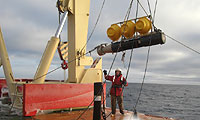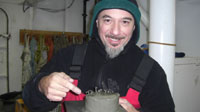

 | |||||||||||||||||||||
|
|
Journals 2008/2009Roy Arezzo
July 31, 2008 There were votes for Q and R, but despite the shift in coordinates to an area east of Elephant Island, Station N (for north) remained the label for the new station. I was out on deck before my watch to catch the remote underwater video system (sometimes referred to as the SCUD for its sleek design) being retrieved from the sea after surveying a kilometer of the seafloor at Station N. The video revealed a flat muddy bottom, and the search for an appropriate area to sample was over.
We spent the entire day working on the regiment of sampling methods. It looked like it would all end well but by the evening the weather had turned and the winds built up fast, dropping the wind chill below -35° C. The rough seas had compromised the Megacore's contact with the bottom and we added weight to the sliding core rack. After the third deployment we obtained our best samples, over 20 centimeters of sediment with a layer of clear "top water" preserved on top. The top water is as important as the sediments since it contains the interface with the sediment's surface and includes the microbial communities and labile organic material. We were hoping for another Megacore deployment, but it was deemed unsafe and time was short so we ended with a Blake trawl. I stayed on deck after the end of my shift to enjoy the last night of science action and watch the Blake trawl come in. Although it was not a very large sample size, our northern Blake trawl catch appeared to be very diverse with many different types of arthropods, worms, and anemones. While we were processing the trawl samples we started our transit back to Chile. Final Samples:
This being our last day of sampling, I laid in my rack reflecting on the last few weeks. Fatigue limited my thought processes, resulting in a disjointed assortment of random observations: I am easily startled by the hand warmer that goes on without warning when using the head near the labs. The moment before your hard hat blows off your head, your hands are always busy. The night shift folks, who have their first meal at midnight (Midnight Rations, AKA Mid-Rats), have a choice of breakfast or lunch food. The kiwis stopped appearing about nine days ago and now we have run out of fresh carrots. Before you can realize he is missing, someone always asks, "Where's Fabio?" More importantly, I have seen that the benthic fauna is diverse and complex. There is much life in the cold wet mud of the deep. It is all gone by so fast and now we are left with paper work, packing, off loading, and maybe some time for more analysis and celebrations - more on that later. |
||||||||||||||||||||




